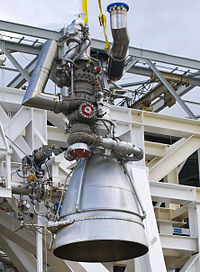NK-15

The Russian NK-33 was modified and renamed the AJ26-58 by Aerojet. This AJ26-58 is shown during a test firing at John C. Stennis Space Center
|
|
| Country of origin | Soviet Union |
|---|---|
| Date | 1970s |
| Designer | Kuznetsov Design Bureau |
| Application | 1st/2nd stage engine |
| Predecessor | NK-15, NK-15V |
| Successor | AJ26-58, AJ26-59, AJ26-62 |
| Liquid-fuel engine | |
| Propellant | LOX / kerosene |
| Cycle | Staged combustion |
| Pumps | Turbopump |
| Performance | |
| Thrust (vac.) | 1,680 kN (380,000 lbf) |
| Thrust (SL) | 1,510 kN (340,000 lbf) |
| Throttle range | 50%-105% |
| Thrust-to-weight ratio | 137 |
| Chamber pressure | 14.83 MPa (2,151 psi) |
| Isp (vac.) | 331 seconds (3.25 km/s) |
| Isp (SL) | 297 seconds (2.91 km/s) |
| Dimensions | |
| Length | 3.7 m (12 ft) |
| Diameter | 2 m (6 ft 7 in) |
| Dry weight | 1,240 kg (2,730 lb) |
| References | |
| References | |
The NK-33 and NK-43 are rocket engines designed and built in the late 1960s and early 1970s by the Kuznetsov Design Bureau. The NK designation is derived from the initials of chief designer Nikolay Kuznetsov. NK-33 was among the most powerful LOX/RP-1 rocket engines when it was built, with a high specific impulse and low structural mass. They were intended for the ill-fated Soviet N-1 rocket moon shot. NK-33A engine is now used on the first stage of the Soyuz-2-1v launch vehicle.
The NK-33 series engines are high-pressure, regeneratively cooled staged combustion cycle bipropellant rocket engines, and use oxygen-rich preburners to drive the turbopumps. The turbopumps require subcooled liquid oxygen (LOX) to cool the bearings. These kinds of burners are highly unusual, since their hot, oxygen-rich exhaust tends to attack metal, causing burn-through failures. The United States had not investigated oxygen-rich combustion technologies until the Integrated Powerhead Demonstrator project in the early 2000s. The Soviets, however, perfected the metallurgy behind this method. The nozzle was constructed from metal, brazed to an outer and inner lining, giving a simple, light, but strong structure. In addition, since the NK-33 uses LOX and RP-1 as propellants, which have similar densities, a single rotating shaft could be used for both turbopumps. The NK-33 engine is among the highest thrust-to-weight ratio of any Earth-launchable rocket engine, only NPO Energomash RD-253 and SpaceX Merlin 1D engine achieve a higher ratio. The specific impulse of the NK-33 is significantly higher than both these engines. The NK-43 is similar to the NK-33, but is designed for an upper stage, not a first stage. It has a longer nozzle, optimized for operation at altitude, where there is little to no ambient air pressure. This gives it a higher thrust and specific impulse, but makes it longer and heavier. It has a thrust-to-weight ratio of about 120:1.
...
Wikipedia
